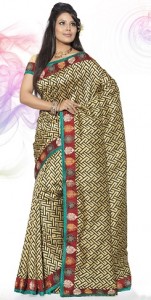There’s a silent but highly visible epidemic sweeping through the South Asian community. It’s prevalent among young South Asian women, specifically those who wear saris without really knowing how to drape them. I’ve come to call it the “Peek-a-Boob.”
Peek-a-Boob: Symptoms & Diagnosis
As the name suggests, the primary effect of the condition is “revealed” when a woman drapes a sari in such a way that one side of her bosom-hugging blouse is perpetually peeking out rather than being draped over by the sari anchal, the portion of the sari that drapes over your front and hangs over your shoulder (also known as a pallu in some parts of India). This can happen because she miscalculated and pinned the anchal too low or she didn’t pin it at all.
Other complicating factors that sari wearers need to take into consideration to prevent the “Peek-a-Boob” are the weight and texture of the sari fabric itself. Heavy sari fabrics will constantly drag downwards so they are best dealt with by pinning them a bit higher and with heavy-duty safety pins. Sheer saris should also be pinned fastidiously because they are slippery suckers.
Seeking Out a Sari Savvy Expert
In addition to arming oneself with heavy duty safety pins, the best cure for this affliction is to seek help from experts. If you don’t have a sari savvy friend or relative nearby, turn to one of the myriad helpful online sari draping tutorials.

As it happens, my mother is a sari draping whiz. It is rare for my family to go to Indian cultural events without my mother being complimented on her sari. And although she has a beautiful collection of saris, I know that the compliments are as much for her draping of the sari as for the sari, itself.
Ironically, because of this, I didn’t get much practice at putting on a sari by myself until well after I had moved out on my own. Before that, on the few occasions I had worn a sari in my late teens, I would put on the petticoat and sari blouse and stand with hands stretched out to the side like an airplane as my mother rotated around me draping it.
I watched how she measured out parts of the sari and allocated them proportionately — this much for the body, that much for the pleats, and this much for the anchal. Then when it had been draped, there were the tweaks, — a pull here, a tuck there. And the last step was to pin the anchal to your sari blouse. Of course, before the sari was even draped on me, I had to decide whether I was going to wear the anchal draped or pleated because this decision affected the anchal allocation.
One Sari’s Mishap is Another’s Flourish
I was also surprised to learn that not all sari mishaps are wardrobe malfunctions. In my [pullquote]Not all sari mishaps are wardrobe malfunctions.[/pullquote]early twenties, several South Asian and South Asian American friends and I decided to wear saris to a desi event. Some wore their own saris while others, like me, wore duds we had borrowed from our mothers. This would be a test to see what I had absorbed from watching my mother drape saris on herself and me.
I had borrowed a rust orange sari with a deep brown border, which had light jeri, gold thread-work, throughout the body of the sari and heavy jeri along the border and anchal. As I stood in my petticoat and blouse tentatively holding one corner of the sari while the remaining yards were pooled on the floor, I tried to recall my mother’s steps and instructions.

Although it took a few attempts, drape, undrape, drape again, I finally got it on and looked in the mirror making minor adjustments. I decided that since this sari was moderately heavy because of the jeri on the border and anchal, I would play it safe and pin the anchal high on my sari blouse with a medium size safety pin.
When I joined my friends at the event, it was clear that some of us knew what we were doing while others looked more like their saris were wearing them. We gathered in the venue’s bathroom and those of us who were more adept helped others.
I helped one of my friends start from scratch and when it came time to drape the anchal she pushed it down so that one side of her bosom was exposed. When I asked her if she needed me to pin it higher on her blouse to prevent the “Peek-a-Boob,” she responded, “nah, I kinda like it like this.” So, all through the night I watched as her sari anchal hung low and though my hands itched, I resisted the temptation to reach out and pull it up.
Sari Symmetry & Me
I want to make clear that I’m not a prude but I have inherited from my mother a certain reverence for the form and aesthetic of the sari.
I have inherited from my mother a certain reverence for the form and aesthetic of the sari.[/pullquote]I don’t care what type of sari blouse a person wears — sleeveless, strapless, spaghetti, what have you. In fact, I don’t care if they wear a blouse at all — I know it’s customary not to wear a blouse in some parts of India.
For me this isn’t about propriety or body shaming but rather symmetry. I feel about it the same way I feel when I walk by a beautiful painting on the wall that is askew. My hands itch in the same way to straighten it so that all is made right in the world again.
Just a few months ago, my husband and I were invited to an Indian wedding. I had put on a sari and was staring at myself in our bedroom mirror while holding a safety pin in one hand and the anchal of my sari pressed to my blouse in the other.
“Do you need some help with that?” he asked. “No, I’ve got it. I’m trying to prevent the “Peek-a-Boob,” I said as I smiled cheekily at him in the mirror, quite proud of the term I had coined. He laughed and said, “Ah yes, my mother calls it O.B.E. — One Boob Exposed.”
After 15 years developing and leading innovative programs in the social change sector, Kavita Das now serves as a nonprofit consultant and writes nonfiction and creative nonfiction. Connect with Kavita on Twitter @kavitamix.












